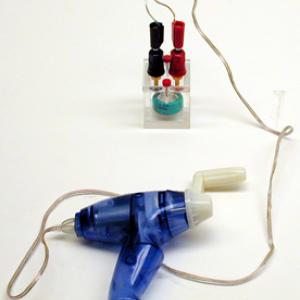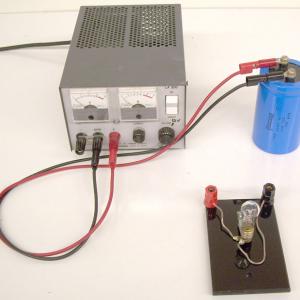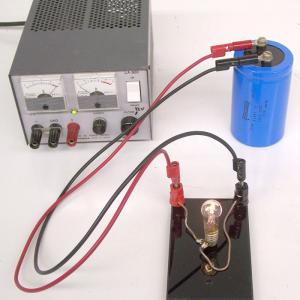College of Liberal Arts & Sciences
5F30.10 - Capacitor - Charge & Discharge
Video Credit: Jonathan M. Sullivan-Wood.
Connect the Genecon to the 1 F capacitor and count the number of turns that you make with the Genecon. Let go of the handle and the capacitor will discharge back through the Genecon and make it act like a motor (the handle will turn). Interestingly enough the handle will turn in the same direction that you were turning it when you charged the capacitor.
Capacitor: You crank the generator handle as you charge it and current flows into it. You have to apply a torque to because the current flowing in the generator makes it want to act like a motor in turing in the opposite direction. You release the handle and now the capacitor discharges and current flows in the opposite direction. This causes the handle to turn in the origional direction.
Coil: You crank the generator applying a torque. Again, because the generator acts like a motor it resists your efforts forcing you and to do work. You release the handle, the current keeps flowing in the same direction (Lenz's Law). This results in a torque in the same direction that registered your efforts origionally and the handle changes direction.
Details of why this is can be found in the file.
Connect the 10,000 MFD capacitor to the 20 VDC power supply. Charge to about 20 volts. Disconnect the capacitor and connect it to the 18 volt light bulb. It should take about 30 seconds until the light bulb no longer glows visibly.
- James Lincoln, "Labs and Demos with a One-Farad Capacitor, TPT, Vol. 61, #5, May 2023, p. 408.
- Douglas T. Young, "Determining Charge Stored on a Capacitor Using Numerical Integration with a Spreadsheet", TPT, Vol. 61, #1, Jan. 2023, p. 31.
- Jake Stanley Bobowski, "Hydraulic Analogues Illustrating the Charging of a Capacitor and Ohm's Law: Labs for Online Learning Environments", TPT, Vol. 59, #7, Oct. 2021, p. 560.
- Alfredo Parra, Jorge Ordenes, and Milton de la Fuente, "Learning Abstract Physical Concepts from Experience: Design and Use of an RC Circuit", TPT, Vol. 56, #5, May 2018, p. 310.
- Carl E. Mungan, "... And Hand-Cranked Induction", TPT, Vol. 52, #9, Dec. 2014, p. 518.
- Art Hovey, "Hand-Cranked Intuition", TPT, Vol. 52, #9, Dec. 2014, p. 518.
- Mieke De Cock and Paul Janssen, "Pharmacokinetics and RC Circuit Concepts", TPT, Vol. 51, #8, Nov. 2013, p. 482.
- Yaakov Kraftmakher, "Charge and Energy Stored in a Capacitor", TPT, Vol. 50, #2, Feb. 2012, p. 73.
- P. Simeão Carvalho, Ana Paula Lima, and Pedro Simeão Carvalho, "Storing the Electric Energy Produced by an AC Generator", TPT, Vol. 48, #5, May 2010, p. 326.
- Joseph Priest, "Meter Resistance: Don't Forget It!", TPT, Vol. 41, #1, Jan 2003, p. 40.
- Melvin S. Steinbergand and Walter Connolly, "Transient Lamp Lighting with High-Tech Capacitors", TPT, Vol. 25, #2, Feb. 1987, p. 95.
- Levi Gray, "Measuring the Energy Stored in a Capacitor", TPT, Vol. 18, #4, Apr. 1980, p. 293.
- Michelle L. Storms, Brad R. Trees, "Charging a Supercapacitor Through a Lamp: A Power-Law RC Decay", AJP, Vol. 90, #12, Dec. 2022, p. 895.
- Robert Ross and Prasad Venugopal, "On the Problem of (Dis)Charging a Capacitor Through a Lamp", AJP, Vol. 74, #6, June 2006, p. 523.
- T. C. Choy, "Capacitors Can Radiate: Further Results For the Two-Capacitor Problem", AJP, Vol. 72, #5, May 2004, p. 662.
- Timothy B. Boykin, Dennis Hite, and Nagendra Singh, "The Two-Capacitor Problem with Radiation", AJP, Vol. 70, #4, Apr. 2002, p. 415.
- A. Gangopadhyaya and J. V. Mallow, "Comment on 'Ideal capacitor circuits and energy conservation,' by K. Mita and M. Boufaida [Am. J. Phys. 67 (8), 737–739 (1999)]", AJP, Vol. 68, #7, July 2000, p. 670.
- K. Mita and M. Boufaida, "Ideal Capacitor Circuits and Energy Conservation", AJP, Vol. 67, #8, Aug. 1999, p. 737.
- Ronald Newburgh, "Two Theorems on Dissipative Energy Losses in Capacitor Systems", Physics Education, Vol. 40 #4, July 2005, p. 370.
- G. D. Freier and F. J. Anderson, "Ed-8", A Demonstration Handbook for Physics.
- G. D. Freier and F. J. Anderson, "Ed-6", A Demonstration Handbook for Physics.
- Earl R. Feltyberger et al., "Energy Storage and Release", Teaching About D. C. Electric Circuits, p. 3.22.
- Borislaw Bilash II and David Maiullo, "Deliverance", A Demo a Day: A Year of Physics of Demonstrations, p. 265.
- Christopher P. Jargodzki and Franklin Potter, "176. A Real Capacitor", Mad About Physics, p. 68, 210.
- Robert Ehrlich, "L.8. Discharging a Capacitor Through a Light Bulb", Turning the World Inside Out and 174 Other Simple Physics Demonstrations, p. 150 - 151.
- W. Bolton, "15. Storage of Charge", Book 4 - Electricity, Physics Experiments and Projects, 1968, p. 31 - 32.
Disclaimer: These demonstrations are provided only for illustrative use by persons affiliated with The University of Iowa and only under the direction of a trained instructor or physicist. The University of Iowa is not responsible for demonstrations performed by those using their own equipment or who choose to use this reference material for their own purpose. The demonstrations included here are within the public domain and can be found in materials contained in libraries, bookstores, and through electronic sources. Performing all or any portion of any of these demonstrations, with or without revisions not depicted here entails inherent risks. These risks include, without limitation, bodily injury (and possibly death), including risks to health that may be temporary or permanent and that may exacerbate a pre-existing medical condition; and property loss or damage. Anyone performing any part of these demonstrations, even with revisions, knowingly and voluntarily assumes all risks associated with them.


